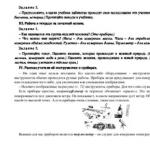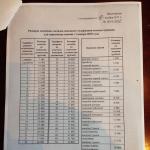Fixed costs (TFC), variable costs (TVC) and their schedules. Determination of total costs. Fixed and variable costs of production Variable costs what applies
Fixed and variable costs are the costs that a company incurs to produce goods, works or services. Their planning allows for more efficient use of available resources, as well as forecasting activities for the future.
Download and get to work:
Fixed costs remain unchanged if the organization reduces the volume of production. In this case, the share of fixed costs will increase per unit of output. And vice versa - with an increase in production volumes, the share of fixed costs per unit of output will decrease. This indicator is average fixed costs (AFC).
Graphically, fixed costs can be represented as a straight line, since they remain unchanged with any changes in production (Fig. 1). Cm. .
Picture 1. direct cost schedule
variable costs
Variable costs depend on the increase or decrease in production volumes. If the organization increases the number of products produced, the costs of materials and resources required for this increase accordingly.
Examples of variable costs:
- Wages of workers with a piece-rate wage system.
- The cost of raw materials and supplies.
- Transportation costs for the delivery of products to the consumer.
- Energy costs, etc.
More on the topic:
What will help: find out what expenses should be cut. It will tell you how to audit business processes and inventory costs, how to motivate employees to save.
What will help: prepare in Excel a report on the expenses of a group of companies in the required detail - by business units, directions, articles and periods
Variable costs change depending on changes in production volumes. With an increase in the amount of output, variable costs will increase, and, conversely, with a decrease in the amount of output, they will decrease. Cm. .
The graph of variable costs has the following form - fig. 2.
Figure 2. variable cost schedule
At the initial stage, the growth of variable costs is directly related to the quantity of output. Gradually, the growth of variable costs slows down, which is associated with cost savings in mass production.
General costs
The sum of all costs, fixed and variable, that an organization spends on the production of goods or services is called total costs (TC - total costs). They depend on the number of production volumes and the cost of resources spent on production. Graphically, the total costs (TC) look like this - fig. 3.
Figure 3.Schedule of fixed, variable and total costs

An example of calculating fixed and variable costs
The Sewing Master JSC company is engaged in tailoring and sale of clothes wholesale and retail. At the beginning of the year, the organization won a tender and signed a long-term contract for a period of 1 year - a large order for tailoring workwear for medical workers in the amount of 5,000 units per year. The organization incurred the following costs during the year (see table).
Table. company costs
|
Type of costs |
Amount, rub. |
|---|---|
|
Rent sewing workshop |
50 000 rub. per month |
|
Depreciation deductions according to accounting data |
48 000 rub. in a year |
|
Interest on a loan for the purchase of sewing equipment and necessary materials(fabrics, threads, sewing accessories, etc.) |
84 000 rub. in a year |
|
Utility bills for electricity, water supply |
18 500 rub. per month |
|
The cost of materials for tailoring workwear (fabrics, threads, buttons and other accessories) |
|
|
Remuneration of workers (working staff of the workshop amounted to 12 people) with an average wages 30 000 rub. |
360 000 rub. per month |
|
Remuneration of administrative staff (3 people) with an average salary 45 000 rub. |
135 000 rub. per month |
|
sewing equipment cost |
Fixed costs include:
- rent for a sewing workshop;
- depreciation deductions;
- payment of interest on a loan for the purchase of equipment;
- the cost of the sewing equipment itself;
- administration salaries.
Calculation of fixed costs:
FC \u003d 50000 * 12 + 48000 + 84000 + 500000 \u003d 1,232,000 rubles per year.
Let's calculate the average fixed costs:
Variable costs include the cost of raw materials and materials, the wages of employees of the sewing workshop and the payment of utility bills.
VC \u003d 200000 + 360000 + 18500 * 12 \u003d 782,000 rubles.
Average variable costs will be:

The sum of fixed and variable costs will give total costs:
TC \u003d 1232000 + 782000 \u003d 20,140,00 rubles.
The average total costs are calculated by the formula:
Results
The organization has just started sewing production: it rents a workshop, purchased sewing equipment on credit. The value of fixed costs at the initial stage is significant. The fact that the volume of production is still low - 5,000 units also plays a role. Therefore, fixed costs so far prevail over variable ones.
With an increase in production, fixed costs will remain unchanged, but variables will increase.
Analysis and planning
Cost planning allows the organization to rationally and more efficiently use available resources, as well as predict its activities for the future (concerning the short term). The analysis is also necessary in order to determine where the most costly items of expenditure are and how you can save on the production of goods.
Saving on fixed and variable costs reduces the cost of production - the organization can set a lower price for its products than before, which increases the competitiveness of products in the market and increases the attractiveness in the eyes of consumers (
VARIABLE COSTS
VARIABLE COSTS
(variable cost) Variable costs are those costs that change with the level of output. They are opposed to the fixed costs that are necessary to make output possible at all; they are independent of the release level. Keep in mind that this is a fundamental difference. The price of a resource used may be stable for years, but it is still a variable cost if the amount of that resource used depends on the output. The price of other resources may vary, but they will still be fixed costs if the amount of resources used does not depend on the level of output.
Economy. Dictionary. - M.: "INFRA-M", Publishing house "Ves Mir". J. Black. General editorial staff: Doctor of Economics Osadchaya I.M.. 2000 .
Economic dictionary. 2000 .
See what "VARIABLE COSTS" is in other dictionaries:
- (variable costs) See: overhead costs. Business. Dictionary. Moscow: INFRA M, Ves Mir Publishing House. Graham Bets, Barry Brindley, S. Williams et al. Osadchaya I.M.. 1998 ... Glossary of business terms
variable costs- VARIABLE COSTS Costs, the value of which varies depending on the change in the volume of production. Variable costs include the costs of variable resources (see Variable factor inputs). Let's look at charts. AT short term… … Dictionary-reference book on economics
variable costs- (costs) Costs that are directly proportional to the volume of production. If output is zero, variable costs are also zero... Investment dictionary
variable costs- Costs that are directly dependent on the volume of production, such as direct costs for materials or labor required to create a finished product. See also fixed cost... Financial and investment explanatory dictionary
variable costs- costs, the size of which depends on the volume of production of the firm ... Economics: glossary
Variable costs are types of expenses, the value of which changes in proportion to changes in production volumes. Contrasted with fixed costs, which add up to total costs. The main sign by which you can determine ... ... Wikipedia
variable costs- monetary and opportunity costs, which change in response to changes in the volume of output. Together with fixed costs, they form total costs. To P.i. include the cost of wages, fuel, materials, etc. ... Dictionary of Economic Theory
variable costs- see variable capital ... Dictionary of many expressions
Costs that are directly related to the volume of production, varying depending on the volume, for example, the cost of materials, raw materials, semi-finished products, piecework wages of workers. Economic dictionary. 2010 ... Economic dictionary
Costs that are directly related to the volume of production, varying depending on the volume, for example, the cost of materials, raw materials, semi-finished products, piecework wages of workers. Terminological dictionary of banking and financial terms.… … Financial vocabulary
In order to determine the total cost of production of different volumes of output and the cost per unit of output, it is necessary to combine production data included in the law of diminishing returns with information on resource prices. As already noted, in the short term, some resources associated with technical equipment businesses remain unchanged. The number of other resources may vary. It follows that in the short term, various types of costs can be classified as either fixed or variable.
fixed costs. Fixed costs are those costs that do not change with changes in the volume of production. Fixed costs are associated with the very existence of the company's production equipment and must be paid even if the company does not produce anything. Fixed costs typically include payment of obligations under bonded loans, bank loans, rent payments, security of the enterprise, payment of utilities (telephone, lighting, sewerage), as well as time wages for employees of the enterprise.
variable costs. Variables are called such costs, the value of which varies depending on changes in the volume of production. These include the cost of raw materials, fuel, energy, transport services, for most of the labor force, etc. The amount of variable costs varies depending on the volume of production.
General costs is the sum of fixed and variable costs for any given volume of production.
General, fixed and variable costs will be shown on the graph (see Fig. 1).

At zero output, the total cost is equal to the firm's fixed costs. Then, for the production of each additional unit of output (from 1 to 10), the total cost changes by the same amount as the sum of variable costs.
The sum of variable costs varies from the origin, and the sum of fixed costs is added to the vertical dimension of the sum of variable costs each time to obtain a total cost curve.
The distinction between fixed and variable costs is significant. Variable costs are costs that can be managed quickly, their value can be changed over a short period of time by changing the volume of production. On the other hand, fixed costs are obviously out of the control of the firm's management. Such costs are mandatory and must be paid regardless of the volume of production.
Examples of Variable Costs
Dependence of cost type on cost object
The concept of direct and indirect costs is conditional.
Properties of Direct Costs
- Direct costs increase in direct proportion to the volume of products produced and are described by a linear function equation in which b=0. If the costs are direct, then in the absence of production they should be equal to zero, the function should start at the point 0 . In financial models, it is allowed to use the coefficient b to reflect the minimum wage of employees due to downtime due to the fault of the enterprise, etc.
- Linear dependence exists only for a certain range of values. For example, if a night shift is introduced with an increase in production volumes, then the payment for the night shift is higher than for the day shift.
See also
Wikimedia Foundation. 2010 .
See what "Variable Costs" is in other dictionaries:
- (variable cost) Variable costs - this is the part of the costs that varies depending on the level of output. They are opposed to the fixed costs that are necessary to make output possible at all; they don't depend on... Economic dictionary
- (variable costs) See: overhead costs. Business. Dictionary. Moscow: INFRA M, Ves Mir Publishing House. Graham Bets, Barry Brindley, S. Williams et al. Osadchaya I.M.. 1998 ... Glossary of business terms
variable costs- VARIABLE COSTS Costs, the value of which varies depending on the change in the volume of production. Variable costs include the costs of variable resources (see Variable factor inputs). Let's look at charts. In the short term... ... Dictionary-reference book on economics Dictionary of Economic Theory
variable costs- see variable capital ... Dictionary of many expressions
Costs that are directly related to the volume of production, varying depending on the volume, for example, the cost of materials, raw materials, semi-finished products, piecework wages of workers. Economic dictionary. 2010 ... Economic dictionary
Costs that are directly related to the volume of production, varying depending on the volume, for example, the cost of materials, raw materials, semi-finished products, piecework wages of workers. Terminological dictionary of banking and financial terms. ... ... Financial vocabulary
Any production activity requires financial costs for material and labor resources. Support cost ratio economic activity with the received profit determines the profitability of the business entity. In the economy of the enterprise, these factors occupy a central position, since they determine the level of competitiveness of the company in the market of similar activities that have a direct impact on the success of the implementation of an entrepreneurial idea.
The costs of the enterprise help to assess its level of profitability
What are costs
Economic activity carried out in any area is always accompanied by certain monetary expenditures for the purchase and use of resources.
These costs in terms of value are called enterprise costs. They not only influence the formation of the balance of income and expenses, but also determine the need to purchase additional production factors, as well as the possibility of investing in this direction. The parameter allows you to determine the efficiency of production activities, as well as the degree of rationality of its organization.
Competence in the economic sphere, concerning the division of costs, allows the head of a business entity to determine in a timely manner the need to apply production methods that reduce costs and increase the return on investment in resources for the purchase of raw materials, materials, equipment and hired labor. Such achievements allow us to improve profitability indicators at the end of the reporting period.
Application of the concept in economic theory

What are production costs
The profit received as a result of economic activity is an important factor in the relationship of a value nature in market economy. It is the main element of the management mechanism of a business entity. It is used to analyze the profitability of a business. Variable and fixed costs, examples of which are discussed below, determine the costs of the enterprise, depending on the value form of the income received. They serve as benchmarks for performance evaluation against which comparative analysis can be carried out.
Representatives of the state apparatus are interested in reducing costs, since this contributes to the growth of income received, which is the main source of replenishment of the budget. Therefore, when planning it, the statistical parameters of business entities in this area are taken into account, which make it possible to determine the potential amount of mandatory deductions.
What determines the value of the parameter
The value of production costs is directly proportional to the cost of acquired factors of resource value. The natural desire of the head of a business entity is to obtain maximum profit at minimum cost. Well organized economic process allows you to save the volume of production activities while minimizing costs, provided by reducing the resources put into circulation.
A business entity, carrying out activities, in the process of implementing its results, incurs additional costs associated with promotion on the market and sales. This article of commercial expenses, called implementation costs, includes financial expenses for the provision of activities. Variable costs also include marketing research, advertising, as well as transportation of products to its consumers.

What is the total cost
Certain items of expenditure include mandatory payments to settlement accounts government agencies such as taxes, fees and contributions to trust funds. These types of cash expenditures are also components of entrepreneurial costs.
Read also: Non-linear depreciation method
Constituent Elements of a Parameter
The value of production costs is formed from three elements:
- cost price;
- price;
- price.
The cost price is called the initial costs of a business entity for the manufacture of a unit of output. The cost parameter includes all applicable types of costs that affect the amount of profit. The implementation of the result of labor is carried out according to market value, taking into account the allowances that form the profit item.
Types of costs

Enterprise cost classification
There are several types of costs that are easier to understand if you imagine the structure of the enterprise. The result of any production is a transaction that determines the sale of the results of labor. The main position of the seller is to cover the costs spent on production activities. Therefore, the cost parameter is primarily laid down in the price. They may be of an economic, accounting or alternative nature.
economic costs

What is economic cost
Economic costs refer to the economic costs of providing a product or service. The constituent elements of the parameter are:
- material and labor resources acquired for the possibility of implementing production activities;
- previously purchased internal resources that are not included in the market turnover, without which the operation of the company is impossible;
- part of the profit, considered as compensation for the risk of possible losses or shortfall in income.
The entrepreneur seeks to compensate for the economic criteria of the parameter in terms of the cost of labor results. If he fails to do this, then the meaning of the functioning of the business is lost, and the head of the business entity should look for himself in other areas of activity.
Accounting

What are accounting costs
Accounting costs include items of expenditure that include funds intended for the acquisition of economic resources. These include expenses that are not used to implement the production cycle, but without which its functioning is impossible:
- payment for mental or physical labor of employees;
- acquisition or lease of land or water resources;
- investment in capital goods, which may be of a physical or financial nature.
Accounting costs include only real and legally documented costs for the purchase of resources. The parameter takes into account the acquisition of equipment, tools, as well as movable and real estate. This category also includes the release valuable papers or shares used in the production process.
Accounting costs are always less than economic costs, because Accounting does not allow abstraction.
The parameter can be direct or indirect. Direct costs take into account the money spent on production. Indirect costs imply cash costs that ensure the normal functioning of production. These include deductions for depreciation of equipment, payment of interest to banking institutions for the use of in cash as well as overhead costs.
Alternative

opportunity cost
Opportunity costs determine the costs of producing the product that the subject entrepreneurial activity probably will not produce due to the use of only individual elements of the process to ensure the functioning of the enterprise. They can be categorized as lost profit opportunities. The value of the parameter corresponds to the difference between economic and accounting costs. It is determined independently by each head of a business entity, depending on his personal idea of the desired profitability of the business.
Classification of the parameter to determine the rational functioning of the enterprise
The growth of production volumes causes an increase in the costs of ensuring the normal functioning of a business entity.
No enterprise can develop and expand indefinitely, since each business entity has individual restrictions regarding the optimal size of the enterprise. To determine the limits of this boundary, apply variable and fixed costs.Such a division is acceptable for short time periods determined by production cycles, during which the factors are practically unchanged. For long term all parameters are categorized as variables.







